Assessment of Climate Change Impacts for Balancing Transboundary Water Resources Development in the Blue Nile Basin
Abstract
:1. Introduction
- (a)
- The combined use of selected GCMs and 30-year observed data.
- (b)
- Analysis of uncertainty in GCM projections.
- (c)
- The use of a distributed hydrological model with a wide range of simulation capabilities.
- (d)
- The application of qualitative assessment to decision making.
2. Materials and Methods
2.1. Study Area
2.2. Data
2.2.1. Topographic Data
2.2.2. Temporal Data
2.3. Methods
2.3.1. Monotonic Trend Analysis
2.3.2. Meteorological Assessment from GCM
2.3.3. Discharge Simulation
2.3.4. Evaluation Indices
2.3.5. Qualitative Assessment
3. Results
3.1. Meteorological Assessment
3.1.1. Temperature
3.1.2. Extreme Precipitation
3.1.3. Total Precipitation
3.2. Uncertainty Analysis
3.3. Hydrological Assessment
3.3.1. Water Balance
3.3.2. Hydrological Extremes
4. Discussion
5. Conclusions
Author Contributions
Funding
Institutional Review Board Statement
Informed Consent Statement
Data Availability Statement
Acknowledgments
Conflicts of Interest
References
- Climate Change 2007: The Physical Science Basis: Contribution of Working Group I to the Fourth Assessment Report of the Intergovernmental Panel on Climate Change; Solomon, S.; Qin, D.; Manning, M.; Chen, Z.; Marquis, M.; Averyt, K.B.; Tignor, M.; Miller, H.L. (Eds.) Cambridge University Press: Cambridge, UK, 2007; p. 996. [Google Scholar]
- Niang, I.; Ruppel, O.C.; Abdrabo, M.A.; Essel, A.; Lennard, C.; Padgham, J.; Urquhart, P.; Adelekan, I.; Archiblad, S.; Balinga, M.; et al. Chapter 22 Africa. In Climate Change 2014: Impacts, Adaptation, and Vulnerability. Part B: Regional Aspects. Contribution of Working Group II to the Fifth Assessment Report of the Intergovernmental Panel on Climate Change; Barros, V.R., Field, C.B., Dokken, D.J., Mastrandrea, M.D., Mach, K.J., Bilir, T.E., Chatterjee, M., Ebi, K.L., Estrada, Y.O., Genova, R.C., et al., Eds.; Cambridge University Press: Cambridge, UK, 2014; pp. 1199–1265. [Google Scholar]
- Möbis, B.; Stevens, B. Factors controlling the position of the Intertropical Convergence Zone on an aquaplanet. J. Adv. Model. Earth Syst. 2012, 4, M00A04. [Google Scholar] [CrossRef]
- Lau, W.K.M.; Kim, K.-M. Robust Hadley Circulation changes and increasing global dryness due to CO2 warming from CMIP5 model projections. Proc. Natl. Acad. Sci. USA 2015, 112, 3630–3635. [Google Scholar] [CrossRef] [Green Version]
- Wheeler, K.G.; Jeuland, M.; Hall, J.W.; Zagona, E.; Whittington, D. Understanding and managing new risks on the Nile with the Grand Ethiopian Renaissance Dam. Nat. Commun. 2020, 11, 1–9. [Google Scholar] [CrossRef] [PubMed]
- Koike, T.; Koudelova, P.; Jaranilla-Sanchez, P.A.; Bhatti, A.M.; Nyunt, C.T.; Tamagawa, K. River management system development in Asia based on Data Integration and Analysis System (DIAS) under GEOSS. Sci. China Earth Sci. 2014, 58, 76–95. [Google Scholar] [CrossRef]
- Goly, A.; Teegavarapu, R.S.V.; Mondal, A. Development and Evaluation of Statistical Downscaling Models for Monthly Precipitation. Earth Interact. 2014, 18, 1–28. [Google Scholar] [CrossRef]
- Rasmy, M.; Koike, T.; Lawford, P.; Hara, M.; Fujita, M.; Kimura, F. Assessment of Future Water Resources in the Tone River Basin Using a Combined Dynamical-Statistical Downscaling Approach. J. Jpn. Soc. Civ. Eng. Ser. B1 (Hydraulic Eng.) 2015, 71, I_73–I_78. [Google Scholar] [CrossRef] [Green Version]
- Hulme, M.; Doherty, R.; Ngara, T.; New, M.; Lister, D. African climate change: 1900–2100. Clim. Res. 2001, 17, 145–168. [Google Scholar] [CrossRef] [Green Version]
- Albritton, D.L.; Barker, T.; Bashmakov, I.A.; Canziani, O.; Christ, R.; Cubasch, U.; Davidson, O.; Gitay, H.; Griggs, D.; Houghton, J.; et al. Climate Change 2001: Synthesis Report; Watson, R.T., Albritton, D.L., Barker, T., Bashmakov, I.A., Canziani, O., Christ, R., Cubasch, U., Davidson, O., Gitay, H., Griggs, D., et al., Eds.; Cambridge University Press: Cambridge, UK, 2001; p. 397. [Google Scholar]
- Elshamy, M.E.; Seierstad, I.A.; Sorteberg, A. Impacts of climate change on Blue Nile flows using bias-corrected GCM scenarios. Hydrol. Earth Syst. Sci. 2009, 13, 551–565. [Google Scholar] [CrossRef] [Green Version]
- Worqlul, A.W.; Dile, Y.T.; Ayana, E.K.; Jeong, J.; Adem, A.A.; Gerik, T. Impact of Climate Change on Streamflow Hydrology in Headwater Catchments of the Upper Blue Nile Basin, Ethiopia. Water 2018, 10, 120. [Google Scholar] [CrossRef] [Green Version]
- Kiros, G.; Shetty, A.; Nandagiri, L. Analysis of variability and trends in rainfall over northern Ethiopia. Arab. J. Geosci. 2016, 9, 451. [Google Scholar] [CrossRef]
- Taye, M.T.; Ntegeka, V.; Ogiramoi, N.P.; Willems, P. Assessment of climate change impact on hydrological extremes in two source regions of the Nile River Basin. Hydrol. Earth Syst. Sci. 2011, 15, 209–222. [Google Scholar] [CrossRef] [Green Version]
- Alemayehu, A.; Bewket, W. Local spatiotemporal variability and trends in rainfall and temperature in the central highlands of Ethiopia. Geogr. Ann. Ser. A, Phys. Geogr. 2017, 99, 85–101. [Google Scholar] [CrossRef]
- Beyene, T.; Lettenmaier, D.P.; Kabat, P. Hydrologic impacts of climate change on the Nile River Basin: Implications of the 2007 IPCC scenarios. Clim. Chang. 2009, 100, 433–461. [Google Scholar] [CrossRef]
- Taye, M.T.; Willems, P. Influence of downscaling methods in projecting climate change impact on hydrological extremes of upper Blue Nile basin. Hydrol. Earth Syst. Sci. Discuss. 2013, 10, 7857–7896. [Google Scholar]
- Ehret, U.; Zehe, E.; Wulfmeyer, V.; Warrach-Sagi, K.; Liebert, J. HESS Opinions Should we apply bias correction to global and regional climate model data? Hydrol. Earth Syst. Sci. 2012, 16, 3391–3404. [Google Scholar] [CrossRef] [Green Version]
- Vaittinada Ayar, P.; Vrac, M.; Mailhot, A. Ensemble bias correction of climate simulations: Preserving internal variability. Sci. Rep. 2021, 11, 3098. [Google Scholar] [CrossRef]
- Mekonnen, D.F.; Disse, M. Analyzing the future climate change of Upper Blue Nile River Basin using statistical down scaling techniques. Hydrol. Earth Syst. Sci. 2018, 22, 2391–2408. [Google Scholar] [CrossRef] [Green Version]
- Fiseha, B.M.; Melesse, A.; Romano, E.; Volpi, E.; Fiori, A. Statistical downscaling of precipitation and temperature for the Upper Tiber Basin in Central Italy. Int. J. Water Sci. 2012, 1. [Google Scholar]
- Hagemann, S.; Chen, C.; O Haerter, J.; Heinke, J.; Gerten, D.; Piani, C. Impact of a Statistical Bias Correction on the Projected Hydrological Changes Obtained from Three GCMs and Two Hydrology Models. J. Hydrometeorol. 2011, 12, 556–578. [Google Scholar] [CrossRef]
- Piani, C.; Haerter, J.O.; Coppola, E. Statistical bias correction for daily precipitation in regional climate models over Europe. Arch. Meteorol. Geophys. Bioclimatol. Ser. B 2009, 99, 187–192. [Google Scholar] [CrossRef] [Green Version]
- Nyunt, C.T.; Koike, T.; Yamamoto, A. Statistical bias correction for climate change impact on the basin scale precipitation in Sri Lanka, Philippines, Japan and Tunisia. Hydrol. Earth Syst. Sci. Discuss. 2016, 27, 1–32. [Google Scholar]
- Tariku, T.B.; Gan, K.E.; Tan, X.; Gan, T.Y.; Shi, H.; Tilmant, A. Global warming impact to River Basin of Blue Nile and the optimum operation of its multi-reservoir system for hydropower production and irrigation. Sci. Total Environ. 2021, 767, 144863. [Google Scholar] [CrossRef] [PubMed]
- Zappa, G.; Shepherd, T.G. Storylines of Atmospheric Circulation Change for European Regional Climate Impact Assessment. J. Clim. 2017, 30, 6561–6577. [Google Scholar] [CrossRef]
- Fajardo, J.; Corcoran, D.; Roehrdanz, P.R.; Hannah, L.; Marquet, P.A. GCM compare R: A web application to assess differences and assist in the selection of general circulation models for climate change research. Methods Ecol. Evol. 2020, 11, 656–663. [Google Scholar] [CrossRef] [Green Version]
- Kawasaki, A.; Yamamoto, A.; Koudelova, P.; Acierto, R.; Nemoto, T.; Kitsuregawa, M.; Koike, T. Data Integration and Analysis System (DIAS) Contributing to Climate Change Analysis and Disaster Risk Reduction. Data Sci. J. 2017, 16, 41. [Google Scholar] [CrossRef] [Green Version]
- Bizuneh, B.B.; Moges, M.A.; Sinshaw, B.G.; Kerebih, M.S. SWAT and HBV models’ response to streamflow estimation in the upper Blue Nile Basin, Ethiopia. Water-Energy Nexus 2021, 4, 41–53. [Google Scholar] [CrossRef]
- Takele, G.S.; Gebre, G.S.; Gebremariam, A.G.; Engida, A.N. Hydrological modeling in the Upper Blue Nile basin using soil and water analysis tool (SWAT). Model. Earth Syst. Environ. 2021, 8, 277–292. [Google Scholar] [CrossRef]
- Worku, G.; Teferi, E.; Bantider, A.; Dile, Y.T. Modelling hydrological processes under climate change scenarios in the Jemma sub-basin of upper Blue Nile Basin, Ethiopia. Clim. Risk Manag. 2021, 31, 100272. [Google Scholar] [CrossRef]
- Selvarajah, H.; Koike, T.; Rasmy, M.; Tamakawa, K.; Yamamoto, A.; Kitsuregawa, M.; Zhou, L. Development of an Integrated Approach for the Assessment of Climate Change Impacts on the Hydro-Meteorological Characteristics of the Mahaweli River Basin, Sri Lanka. Water 2021, 13, 1218. [Google Scholar] [CrossRef]
- United Nations Development Programme (UNDP). Sendai Framework for Disaster Risk Reduction (2015–2030). Available online: https://www.undp.org/myanmar/publications/sendai-framework-disaster-risk-reduction-2015-2030 (accessed on 15 October 2022).
- United Nations Framework Convention on Climate Change (UNFCCC). Adoption of the Paris Agreement. 2015. Available online: https://unfccc.int/resource/docs/2015/cop21/eng/l09r01.pdf (accessed on 12 January 2019).
- World Bank. Africa Development Indicators 2006: From the World Bank Africa Database; The World Bank: Washington, DC, USA, 2006. [Google Scholar]
- Seleshi, Y.; Demaree, G.R. Rainfall Variability in the Ethiopian and Eritrean Highlands and its Links with the Southern Oscillation Index. J. Biogeogr. 1995, 22, 945–952. [Google Scholar] [CrossRef]
- Sellers, P.J.; Randall, D.A.; Collatz, G.J.; Berry, J.A.; Field, C.B.; Dazlich, D.A.; Zhang, C.; Collelo, G.D.; Bounoua, L. A Revised Land Surface Parameterization (SiB2) for Atmospheric GCMS. Part I: Model Formulation. J. Clim. 1996, 9, 676–705. [Google Scholar] [CrossRef]
- Tedla, M.; Cho, Y.; Jun, K. Flood Mapping from Dam Break Due to Peak Inflow: A Coupled Rainfall–Runoff and Hydraulic Models Approach. Hydrology 2021, 8, 89. [Google Scholar] [CrossRef]
- Kobayashi, S.; Ota, Y.; Harada, Y.; Ebita, A.; Moriya, M.; Onoda, H.; Onogi, K.; Kamahori, H.; Kobayashi, C.; Endo, H.; et al. The JRA-55 Reanalysis: General Specifications and Basic Characteristics. J. Meteorol. Soc. Jpn. Ser. II 2015, 93, 5–48. [Google Scholar] [CrossRef]
- Mann, H.B. Nonparametric tests against trend. Econometrica 1945, 13, 245–259. [Google Scholar] [CrossRef]
- Kendall, M.G. Further Contributions to the Theory of Paired Comparisons. Biometrics 1955, 11, 43. [Google Scholar] [CrossRef]
- Sen, P.K. Estimates of the Regression Coefficient Based on Kendall’s Tau. J. Am. Stat. Assoc. 1968, 63, 1379–1389. [Google Scholar] [CrossRef]
- Hamed, K.H.; Rao, A.R. A modified Mann-Kendall trend test for autocorrelated data. J. Hydrol. 1998, 204, 182–196. [Google Scholar] [CrossRef]
- Intergovernmental Panel on Climate Change (IPCC). Summary for Policymakers. Climate Change 2022: Mitigation of Climate Change. Contribution of Working Group III to the Sixth Assessment Report of the Intergovernmental Panel on Climate Change. Available online: https://www.ipcc.ch/report/ar6/wg3/downloads/report/IPCC_AR6_WGIII_SPM.pdf (accessed on 1 November 2022).
- Rasmy, M.; Sayama, T.; Koike, T. Development of water and energy Budget-based Rainfall-Runoff-Inundation model (WEB-RRI) and its verification in the Kalu and Mundeni River Basins, Sri Lanka. J. Hydrol. 2019, 579, 124163. [Google Scholar] [CrossRef]
- Intergovernmental Panel on Climate Change (IPCC). Climate Change 2014: Synthesis Report. Contribution of Working Groups I, II and III to the Fifth Assessment Report of the Intergovernmental Panel on Climate Change; Core Writing Team, Pachauri, R.K., Meyer, L.A., Eds.; IPCC: Geneva, Switzerland, 2014. [Google Scholar]
- van den Hurk, B.; van Oldenborgh, G.J.; Lenderink, G.; Hazeleger, W.; Haarsma, R.; de Vries, H. Drivers of mean climate change around the Netherlands derived from CMIP5. Clim. Dyn. 2014, 42, 1683–1697. [Google Scholar] [CrossRef] [Green Version]
- Hwang, Y.-T.; Frierson, D.M.W. Link between the double-Intertropical Convergence Zone problem and cloud biases over the Southern Ocean. Proc. Natl. Acad. Sci. USA 2013, 110, 4935–4940. [Google Scholar] [CrossRef] [Green Version]
- Allam, M.M.; Figueroa, A.J.; McLaughlin, D.B.; Eltahir, E.A.B. Estimation of evaporation over the upper Blue Nile basin by combining observations from satellites and river flow gauges. Water Resour. Res. 2016, 52, 644–659. [Google Scholar] [CrossRef] [Green Version]
- Beltrando, G.; Camberlin, P. Interannual variability of rainfall in the eastern horn of Africa and indicators of atmospheric circulation. Int. J. Clim. 1993, 13, 533–546. [Google Scholar] [CrossRef]
- Mwalichi, J.I. The characteristics of rainfall in Ethiopia and its relationship to El-Nino Southern Oscillation. In Proceedings of the First Technical Conference on Meteorological Research in Eastern and Southern Africa, Nairobi, Kenya, 6–9 January 1987. [Google Scholar]
- Camberlin, P.; Fontaine, B.; Louvet, S.; Oettli, P.; Valimba, P. Climate Adjustments over Africa Accompanying the Indian Monsoon Onset. J. Clim. 2010, 23, 2047–2064. [Google Scholar] [CrossRef]
- Basheer, M. Cooperative operation of the Grand Ethiopian Renaissance Dam reduces Nile riverine floods. River Res. Appl. 2021, 37, 805–814. [Google Scholar] [CrossRef]
- Kahsay, T.N.; Kuik, O.; Brouwer, R.; van der Zaag, P. Estimation of the transboundary economic impacts of the Grand Ethiopia Renaissance Dam: A computable general equilibrium analysis. Water Resour. Econ. 2015, 10, 14–30. [Google Scholar] [CrossRef]
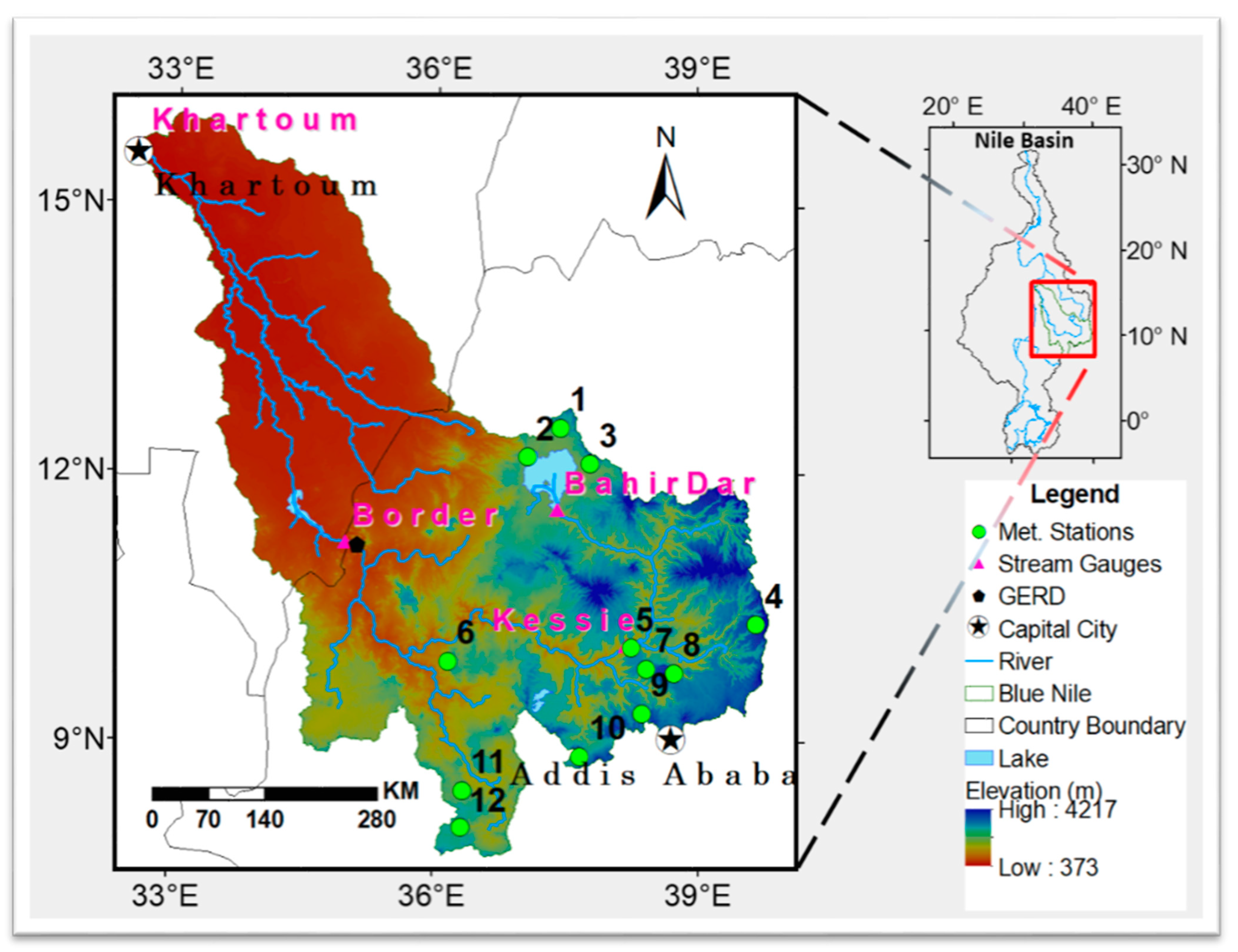
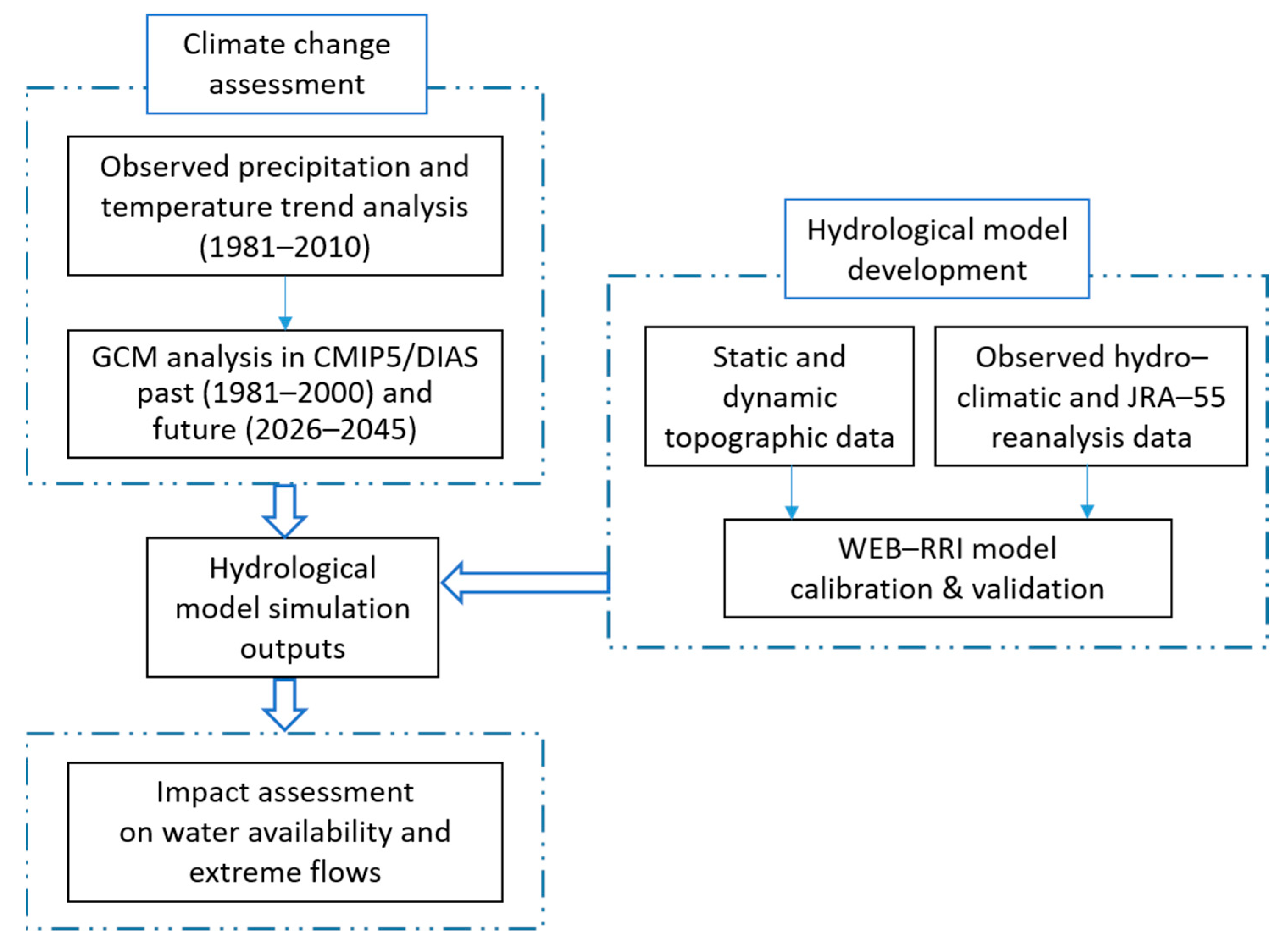
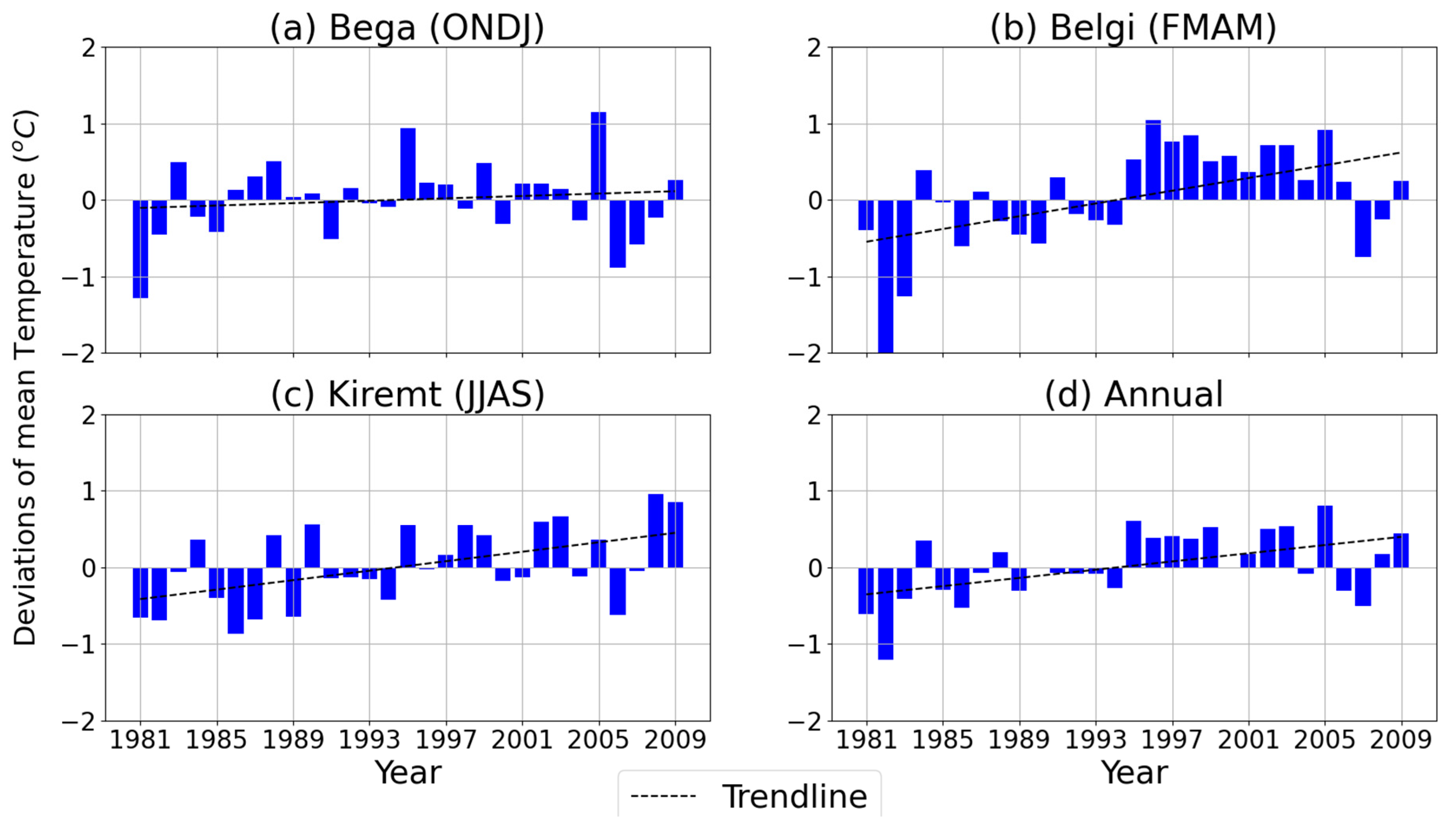
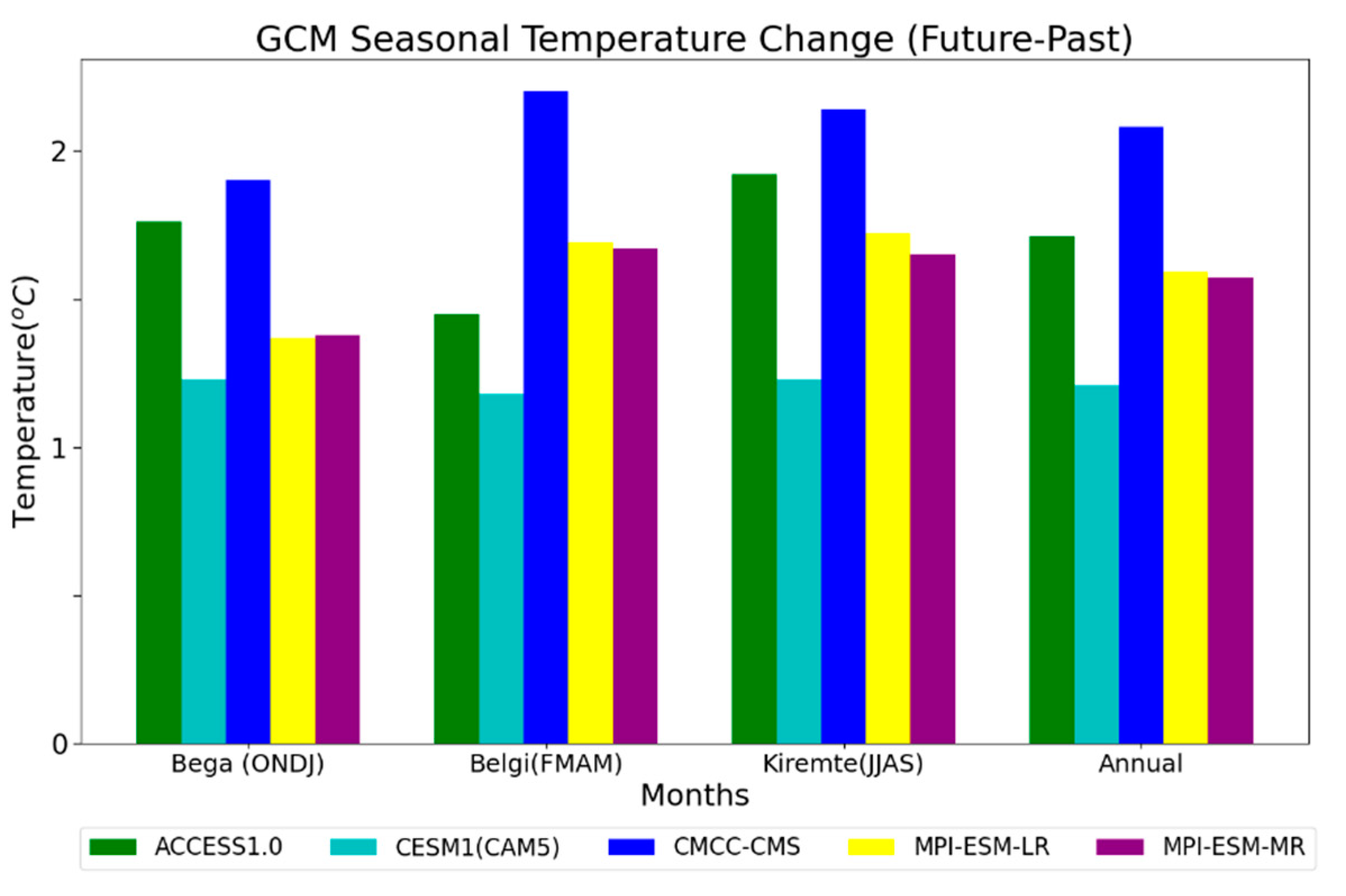
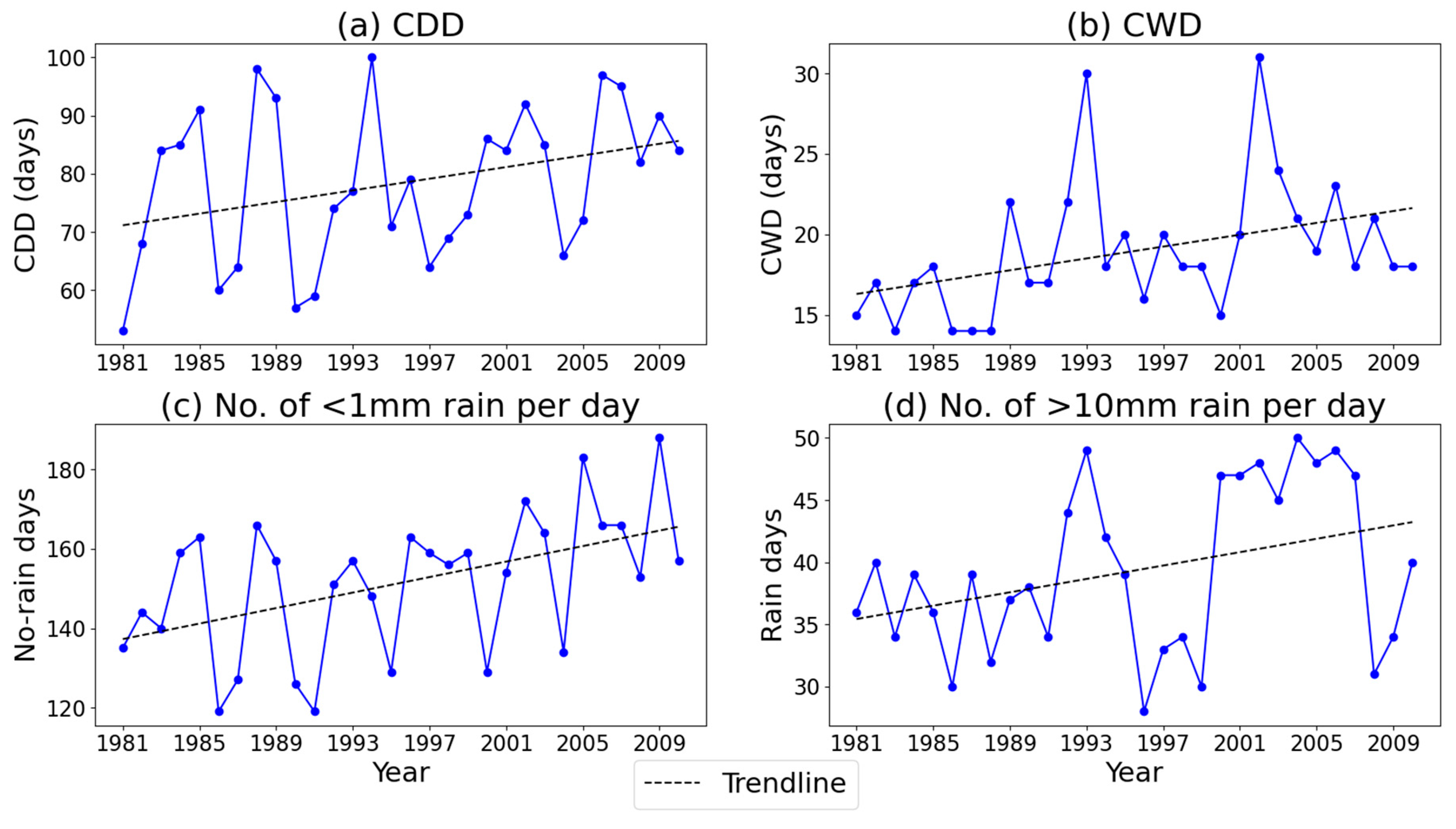


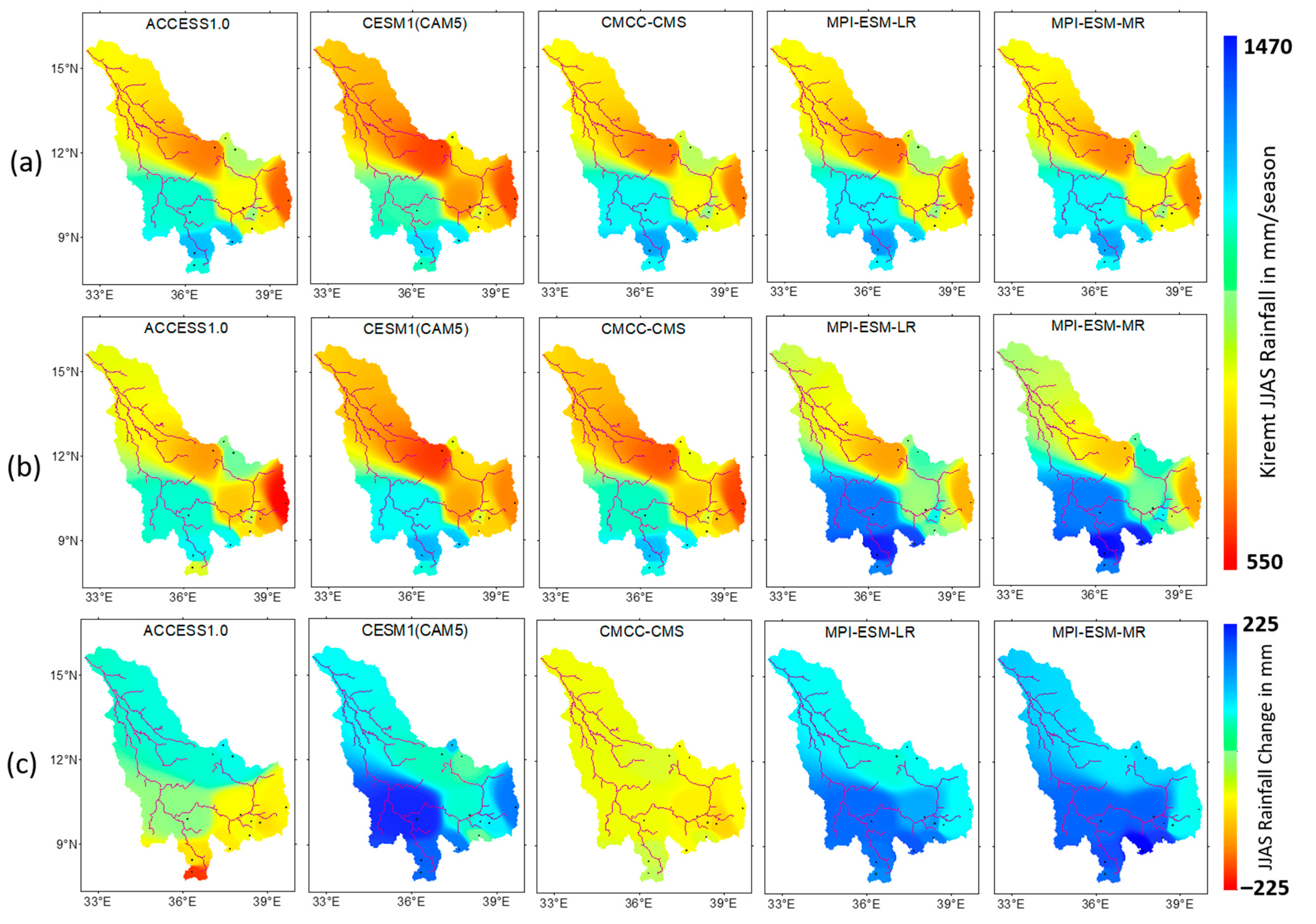



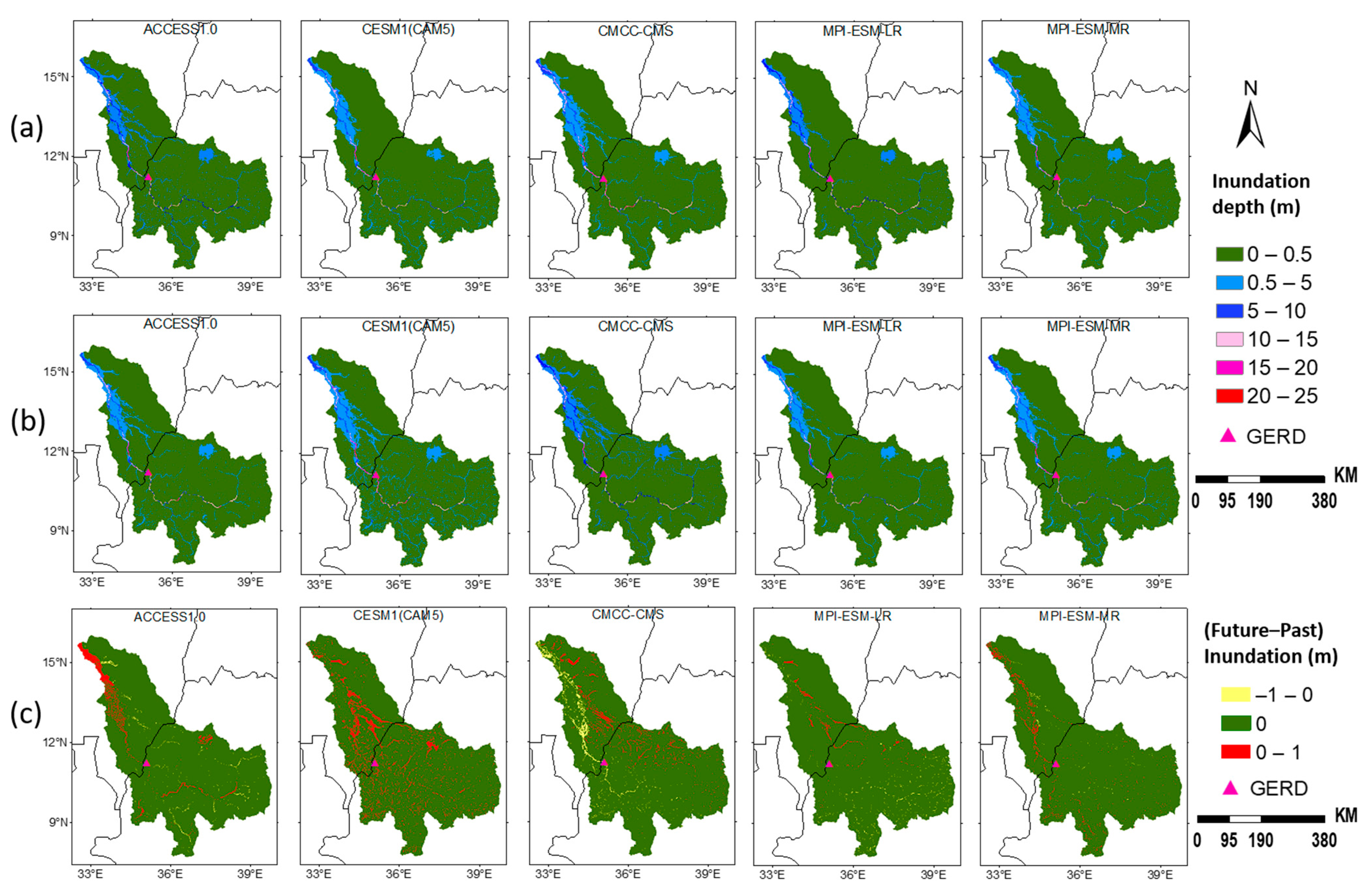

| Test | Jan | Feb | Mar | Apr | May | Jun | Jul | Aug | Sep | Oct | Nov | Dec | |
|---|---|---|---|---|---|---|---|---|---|---|---|---|---|
| Gondar | MK (Z) | 0 | −0.41 | 0 | −0.11 | 0.62 | 1.13 | 1.64 | 2.2 | 1.24 | −0.33 | −0.68 | −0.17 |
| Sen’s (Q) | 0 | 0 | 0 | −0.08 | 1.3 | 3.11 | 3.1 | 4.54 | 1.33 | −0.78 | −0.14 | 0 | |
| Delgi | MK (Z) | 0.4 | −0.46 | 0.2 | −0.18 | 0.32 | 1.23 | 1.74 | 1.6 | 1.2 | −0.43 | −0.82 | −0.07 |
| Sen’s (Q) | 0 | 0 | 0 | −0.18 | 1.2 | 2.11 | 2.1 | 3.7 | 1.1 | −0.58 | −0.24 | 0 | |
| Addis zemen | MK (Z) | 1.25 | −0.31 | 0.18 | 0.28 | 0.96 | 1.86 | 0.45 | 0.73 | 1.35 | −1.75 | 0 | −1.81 |
| Sen’s (Q) | 0 | 0 | 0 | 0.1 | 1.65 | 5.61 | 3.14 | 1.73 | 4.04 | −1.77 | 0 | −1.82 | |
| Mehal_meda | MK (Z) | 1.34 | −2.1 | −0.17 | −0.99 | 0.28 | 1.35 | 0.67 | −0.96 | 0.34 | −1.41 | 1.48 | −0.29 |
| Sen’s (Q) | 0.5 | −2.94 | −0.48 | −1.15 | 0.26 | 1.43 | 2.49 | −1.79 | 0.48 | −0.53 | 0 | 0 | |
| Filiklik | MK (Z) | −0.71 | 1.45 | −1.21 | −0.93 | 0.39 | 2.43 | 1.07 | 0.06 | −0.17 | −0.59 | 1.53 | −1.08 |
| Sen’s (Q) | 0 | −0.46 | −1.43 | −1.11 | 0.68 | 6.8 | 4.3 | 0.45 | −0.93 | −0.72 | 0 | 0 | |
| Uka | MK (Z) | −1.19 | −0.4 | −0.99 | −0.17 | −0.68 | −0.51 | 1.02 | −1.3 | 0.39 | −0.73 | −0.51 | −0.4 |
| Sen’s (Q) | −0.51 | −0.09 | −1.03 | −0.38 | −3.16 | −1.53 | 2.86 | −3.77 | 1.95 | −2.15 | −0.62 | −0.06 | |
| Gebrguracha | MK (Z) | 0.45 | −0.4 | −0.03 | −0.31 | 0.85 | 2.26 | 0.79 | −0.85 | 0 | 0.4 | 1.05 | −0.15 |
| Sen’s (Q) | 0.1 | 0 | 0 | −0.32 | 1.79 | 4.95 | 1.96 | −1.77 | 0.17 | 0.06 | 0.01 | 0 | |
| Fiche | MK (Z) | 0.99 | −2.03 | −0.9 | −0.87 | 0.62 | 2.03 | 1.35 | −0.23 | −0.9 | −0.08 | 1.8 | −0.55 |
| Sen’s (Q) | 0.15 | −2.35 | −0.78 | −1.4 | 0.65 | 2.2 | 4.79 | −0.53 | −1.11 | −0.03 | 0.18 | 0 | |
| Enchini | MK (Z) | −0.37 | −2.28 | 0.34 | −0.23 | 1.24 | 1.64 | 0.28 | 0.11 | 0.06 | −0.68 | 0.85 | −0.45 |
| Sen’s (Q) | −0.28 | −2 | 0.68 | −0.3 | 3.1 | 2.75 | 1.03 | 0.18 | 0.14 | −0.95 | 0.24 | −0.13 | |
| Tikurenchini | MK (Z) | 0.2 | −2.54 | −0.28 | 1.41 | 0.85 | 1.52 | 0.62 | −0.45 | 1.97 | 0.68 | 0.17 | −1 |
| Sen’s (Q) | 0.11 | −2.33 | −0.89 | 5.5 | 1.86 | 3.8 | 1.14 | −1.35 | 5.44 | 1.42 | 0 | −0.47 | |
| Bedele | MK (Z) | −0.87 | −1.13 | −1.13 | 0.23 | 0.79 | 1.69 | 1.69 | 1.24 | 0.85 | −0.28 | 0.93 | −0.79 |
| Sen’s (Q) | −0.32 | −0.6 | −1.2 | 0.18 | 2.52 | 4.37 | 4.75 | −2.46 | 2.35 | −0.97 | 1.22 | −0.35 | |
| Setema | MK (Z) | −0.11 | −1.75 | −1.52 | 0.68 | 1.33 | −1.18 | 1.13 | −1.07 | 0 | −0.39 | −1.18 | −1.38 |
| Sen’s (Q) | −0.18 | −1.9 | −2.3 | 1.2 | 4.13 | −2.81 | 3.3 | −2.45 | 0.06 | −1.57 | −0.99 | −0.69 |
| Parameter | Observed | ACCESS 1.0 | CESM1 (CAM5) | CMCC-CMS | MPI-ESM-LR | MPI-ESM-MR |
|---|---|---|---|---|---|---|
| NSE | 0.84 | 0.66 | 0.44 | 0.58 | 0.72 | 0.72 |
| MBE (m3/s) | −97.59 | −126.78 | −184.44 | −127.28 | −97.14 | −127.73 |
| RMSE (m3/s) | 262.02 | 383.91 | 491.53 | 425.57 | 348.02 | 347.36 |
| Location | GCM Annual Flow Difference in % (Future – Past/Past × 100) | ||||
|---|---|---|---|---|---|
| ACCESS 1.0 | CESM1 (CAM5) | CMCC-CMS | MPI-ESM-LR | MPI-ESM-MR | |
| Bahir-Dar | −5.3 | 0.5 | −24.0 | 3.6 | 20.4 |
| Kessie | −10.3 | 5.6 | −26.7 | 7.5 | 15.8 |
| Sudan Border | −15.1 | 11.5 | −33.3 | 8.9 | 18.3 |
| Khartoum | −6.1 | 9.7 | −25.7 | 5.2 | 16.3 |
| Meteorological Assessment | Hydrological Assessment | |||||
|---|---|---|---|---|---|---|
| Temperature | Extreme Rainfall | Total Rainfall | Total Discharge | High Flow (Flood) | Low Flow (Drought) | |
| Level of confidence | Extremely likely increase | Very likely increase | Likely increase | Likely increase | Very likely increase | Very likely increase |
Publisher’s Note: MDPI stays neutral with regard to jurisdictional claims in published maps and institutional affiliations. |
© 2022 by the authors. Licensee MDPI, Basel, Switzerland. This article is an open access article distributed under the terms and conditions of the Creative Commons Attribution (CC BY) license (https://creativecommons.org/licenses/by/4.0/).
Share and Cite
Tedla, M.G.; Rasmy, M.; Tamakawa, K.; Selvarajah, H.; Koike, T. Assessment of Climate Change Impacts for Balancing Transboundary Water Resources Development in the Blue Nile Basin. Sustainability 2022, 14, 15438. https://doi.org/10.3390/su142215438
Tedla MG, Rasmy M, Tamakawa K, Selvarajah H, Koike T. Assessment of Climate Change Impacts for Balancing Transboundary Water Resources Development in the Blue Nile Basin. Sustainability. 2022; 14(22):15438. https://doi.org/10.3390/su142215438
Chicago/Turabian StyleTedla, Mihretab G., Mohamed Rasmy, Katsunori Tamakawa, Hemakanth Selvarajah, and Toshio Koike. 2022. "Assessment of Climate Change Impacts for Balancing Transboundary Water Resources Development in the Blue Nile Basin" Sustainability 14, no. 22: 15438. https://doi.org/10.3390/su142215438
APA StyleTedla, M. G., Rasmy, M., Tamakawa, K., Selvarajah, H., & Koike, T. (2022). Assessment of Climate Change Impacts for Balancing Transboundary Water Resources Development in the Blue Nile Basin. Sustainability, 14(22), 15438. https://doi.org/10.3390/su142215438







